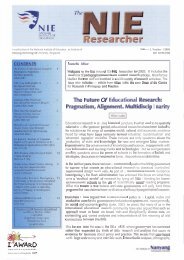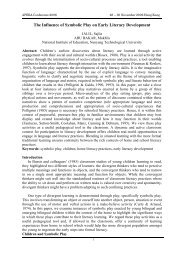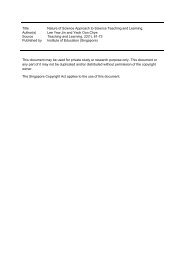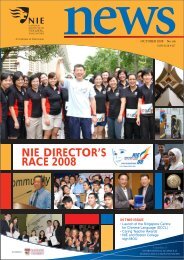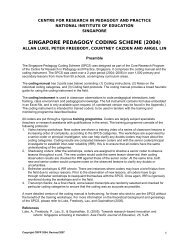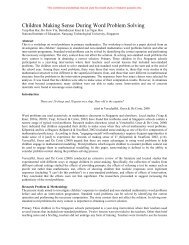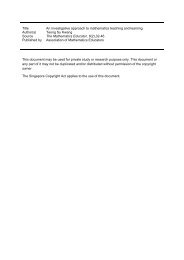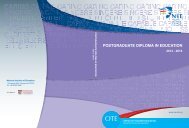Classroom interaction analysis techniques for classroom teachers ...
Classroom interaction analysis techniques for classroom teachers ...
Classroom interaction analysis techniques for classroom teachers ...
Create successful ePaper yourself
Turn your PDF publications into a flip-book with our unique Google optimized e-Paper software.
Redesigning Pedagogy 2011 10past, a Specific Focus project of a comparative study by using <strong>classroom</strong> observation codingscheme has been completed and the general picture of pedagogical <strong>interaction</strong> in Chinese language<strong>classroom</strong> has been detailed (in <strong>for</strong>m of tabulation and percentage counting) in the findings reportedin both preliminary and final technical reports. Now, policy makers hope to see this kind ofpedagogical <strong>interaction</strong> (both IRF and oral/aural exercise among the learners) in a more detailed andindividual dimension. SNA method provides not only a graphical and intuitive network pictureshowing oral/aural communication patterns and effectiveness occurred in classes, but also acomparative basis to find out the differences and similarities between different modules under thenew modular curriculum launched since 2006 across Singaporean primary education system, aswell as the modular classes (as experimental groups) and the old classes (as control group, throughutilizing the existing CRPP data collected since 2003). Initial literature scan finds that the majormetrics used in SNA are applicable in looking at features of pedagogical <strong>interaction</strong> in language<strong>classroom</strong>. It can be a powerful research approach to visualize <strong>classroom</strong> discourse, thus a goodanswer to key concerns revolving around the effectiveness and efficiency of ef<strong>for</strong>ts committed inimproving students’ oral communicative skills. Given the difficulties and time consuming tocapture the individual speech in a normal <strong>classroom</strong>, the use of SNA approach in <strong>classroom</strong> data<strong>analysis</strong> in current project will be limited to case study.SNA Metrics Applicable in Language Interaction AnalysisAs mentioned earlier, a social network is a social structure made of individuals (ororganizations) called "nodes," which are tied (connected) by one or more specific types ofinterdependency, such as friendship, kinship, financial exchange, dislike, sexual relationships, orrelationships of beliefs, knowledge or even prestige. To understand networks and their participants,researchers evaluate the location of actors in the network. Measuring the network location is findingthe centrality of a node. These measures give us insight into the various roles and groupings in anetwork – who are the connectors, leaders, bridges, isolates, where are the clusters and who is inthem, who is in the core of the network, and who is on the periphery?




